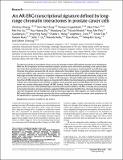| dc.contributor.author | Zhang, Zhizhuo | |
| dc.contributor.author | Chng, Kern Rei | |
| dc.contributor.author | Lingadahalli, Shreyas | |
| dc.contributor.author | Chen, Zikai | |
| dc.contributor.author | Liu, Mei Hui | |
| dc.contributor.author | Do, Huy Hoang | |
| dc.contributor.author | Cai, Shaojiang | |
| dc.contributor.author | Rinaldi, Nicola | |
| dc.contributor.author | Poh, Huay Mei | |
| dc.contributor.author | Li, Guoliang | |
| dc.contributor.author | Sung, Ying Ying | |
| dc.contributor.author | Heng, Charlie L. | |
| dc.contributor.author | Core, Leighton J. | |
| dc.contributor.author | Tan, Si Kee | |
| dc.contributor.author | Ruan, Xiaoan | |
| dc.contributor.author | Lis, John T. | |
| dc.contributor.author | Kellis, Manolis | |
| dc.contributor.author | Ruan, Yijun | |
| dc.contributor.author | Sung, Wing-Kin | |
| dc.contributor.author | Cheung, Edwin | |
| dc.date.accessioned | 2020-10-05T19:06:42Z | |
| dc.date.available | 2020-10-05T19:06:42Z | |
| dc.date.issued | 2019-01 | |
| dc.date.submitted | 2017-09 | |
| dc.identifier.issn | 1088-9051 | |
| dc.identifier.issn | 1549-5469 | |
| dc.identifier.uri | https://hdl.handle.net/1721.1/127808 | |
| dc.description.abstract | The aberrant activities of transcription factors such as the androgen receptor (AR) underpin prostate cancer development. While the AR cis-regulation has been extensively studied in prostate cancer, information pertaining to the spatial architecture of the AR transcriptional circuitry remains limited. In this paper, we propose a novel framework to profile long-range chromatin interactions associated with AR and its collaborative transcription factor, erythroblast transformation-specific related gene (ERG), using chromatin interaction analysis by paired-end tag (ChIA-PET). We identified ERG-associated long-range chromatin interactions as a cooperative component in the AR-associated chromatin interactome, acting in concert to achieve coordinated regulation of a subset of AR target genes. Through multifaceted functional data analysis, we found that AR-ERG interaction hub regions are characterized by distinct functional signatures, including bidirectional transcription and cotranscription factor binding. In addition, cancer-associated long noncoding RNAs were found to be connected near protein-coding genes through AR-ERG looping. Finally, we found strong enrichment of prostate cancer genome-wide association study (GWAS) single nucleotide polymorphisms (SNPs) at AR-ERG co-binding sites participating in chromatin interactions and gene regulation, suggesting GWAS target genes identified from chromatin looping data provide more biologically relevant findings than using the nearest gene approach. Taken together, our results revealed an ARERG- centric higher-order chromatin structure that drives coordinated gene expression in prostate cancer progression and the identification of potential target genes for therapeutic intervention. | en_US |
| dc.language.iso | en | |
| dc.publisher | Cold Spring Harbor Laboratory | en_US |
| dc.relation.isversionof | http://dx.doi.org/10.1101/gr.230243.117 | en_US |
| dc.rights | Creative Commons Attribution NonCommercial License 4.0 | en_US |
| dc.rights.uri | https://creativecommons.org/licenses/by-nc/4.0/ | en_US |
| dc.source | Cold Spring Harbor Laboratory Press | en_US |
| dc.title | An AR-ERG transcriptional signature defined by long-range chromatin interactomes in prostate cancer cells | en_US |
| dc.type | Article | en_US |
| dc.identifier.citation | Zhang, Zhizhuo et al. "An AR-ERG transcriptional signature defined by long-range chromatin interactomes in prostate cancer cells." Genome Research 29, 2 (January 2019): 223-235 © 2019 Zhang et al. | en_US |
| dc.contributor.department | Massachusetts Institute of Technology. Computer Science and Artificial Intelligence Laboratory | en_US |
| dc.relation.journal | Genome Research | en_US |
| dc.eprint.version | Final published version | en_US |
| dc.type.uri | http://purl.org/eprint/type/JournalArticle | en_US |
| eprint.status | http://purl.org/eprint/status/PeerReviewed | en_US |
| dc.date.updated | 2019-06-07T15:51:14Z | |
| dspace.date.submission | 2019-06-07T15:51:18Z | |
| mit.journal.volume | 29 | en_US |
| mit.journal.issue | 2 | en_US |
| mit.metadata.status | Complete | |
